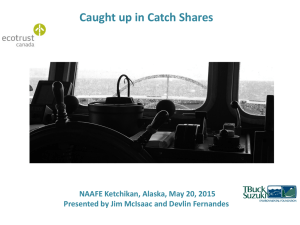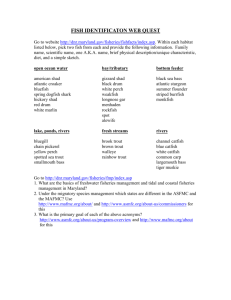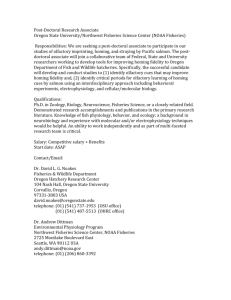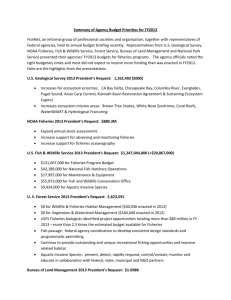Syllabus: Short Course on Fisheries Economics
advertisement
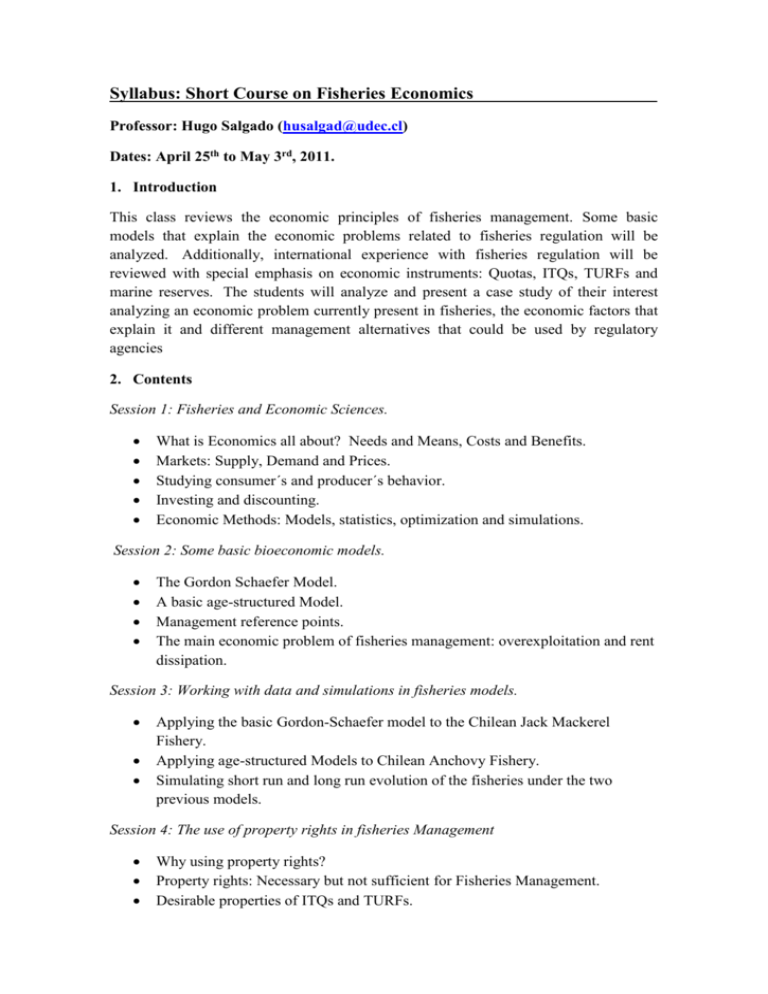
Syllabus: Short Course on Fisheries Economics Professor: Hugo Salgado (husalgad@udec.cl) Dates: April 25th to May 3rd, 2011. 1. Introduction This class reviews the economic principles of fisheries management. Some basic models that explain the economic problems related to fisheries regulation will be analyzed. Additionally, international experience with fisheries regulation will be reviewed with special emphasis on economic instruments: Quotas, ITQs, TURFs and marine reserves. The students will analyze and present a case study of their interest analyzing an economic problem currently present in fisheries, the economic factors that explain it and different management alternatives that could be used by regulatory agencies 2. Contents Session 1: Fisheries and Economic Sciences. What is Economics all about? Needs and Means, Costs and Benefits. Markets: Supply, Demand and Prices. Studying consumer´s and producer´s behavior. Investing and discounting. Economic Methods: Models, statistics, optimization and simulations. Session 2: Some basic bioeconomic models. The Gordon Schaefer Model. A basic age-structured Model. Management reference points. The main economic problem of fisheries management: overexploitation and rent dissipation. Session 3: Working with data and simulations in fisheries models. Applying the basic Gordon-Schaefer model to the Chilean Jack Mackerel Fishery. Applying age-structured Models to Chilean Anchovy Fishery. Simulating short run and long run evolution of the fisheries under the two previous models. Session 4: The use of property rights in fisheries Management Why using property rights? Property rights: Necessary but not sufficient for Fisheries Management. Desirable properties of ITQs and TURFs. ITQ Markets. Session 5: Simulating the Effects of ITQs in the short run. Estimating production functions and short run demand for quotas. Simulating a static ITQ market. Simulating the effects of illegal fishing on the ITQ market. Simulating the ITQ market under market power. Session 6: Simulating long-run effects of ITQs and property rights. Costly adjustment in the effort and fleet size. Simulating the impact of ITQs in the long run. Measuring the long run economic benefits from ITQs. Session 7: Fisheries Management 3: Short presentations by students. Topics to define. 3. Evaluation: The evaluation of the class will be based on a short report presented by each student presenting a current problem of fisheries management that can be analyzed from the economic sciences perspective. The report needs to include a brief description of the problem to be analyzed and a literature review of experiences, models and methods that can be used to understand the problem and propose policy management. The analysis needs to be done from the economics sciences perspective. Extra points can be obtained by making a short presentation during the last session about the problem to be analyzed where feedback can be obtained from the class. Students can choose among the following topics: - International experiences with ITQs: Are real fisheries following the theory? International experiences with TURFs: Any lessons learned? The use of taxes and subsidies to manage fisheries. Systems used to allocate global quotas among fishermen: the pros and cons of each one. How do countries actually set TACs? The role of biological, economic and social pressure when setting quotas. The role of Marine Protected Areas to manage commercial fisheries. Managing shared stocks: problems and tools to manage international fisheries. How valuable is it to protect the oceans biodiversity? Managing small-scale and large-scale shared fisheries. The role of aquaculture in sustaining global fisheries. Other topics proposed by the student and accepted by the professor. 4. References: (In bold, main references to review in classes) 4.1 Books: Clark, C. 1990. "Mathematical Bioeconomics. The optimal management of renewable resources", Second Edition, John Wiley & Sons, Inc. Conrad, J. 1999. “Resource Economics”. Cambridge University Press. Conrad, J. and C. Clark. 19995. “Natural Resource Economics. Notes and Problems”. Cambridge University Press. Mangel, M. 2006. “The theoretical Biologist´s Toolbox. Quantitative Methods for Ecology and Evolutionary Biology”, Cambridge University Press. Chapter 6. 4.2 Journal Articles: Anderson, L. (1995). “Privatizing Open Access Fisheries: Individual Transferable Quotas”, cap. 20 en The Handbook of Environmental Economics, Edited by Daniel W. Bromley, Blackwell Handbooks in Economics. Arnason, R. (2002), “A Review of International Experiences with ITQs” CEMARE Report 58, Annex to Future Options for UK Fish Quota Management. Report to the Department for the Environment, Food and Rural Affairs. CEMARE, University of Portsmouth, June 2002. Bernal, P., D. Oliva, B. Aliaga y C. Morales. 1999. "New Regulations in Chilean Fisheries and Aquaculture: ITQ's and Territorial Users Rights". Ocean & Coastal Management 42: 119-142. Castilla, Juan Carlos (2010) “Fisheries in Chile: Small Pelagics,Management, Rights, and Sea Zoning”, BULLETIN OF MARINE SCIENCE, 86(2): 221–234. Chávez, Carlos y Hugo Salgado. 2005. "Individual Transferable Quota Markets under Illegal Fishing", Environment and Resource Economics, 31 (3): 303-324. Chávez, C., N. González y H. Salgado. (2008). “ITQs Under Illegal Fishing: An Application to the Red Shrimp Fishery in Chile”, Marine Policy 32: 570-579. Gómez-Lobo, A., J. Peña, y P. Barría (2007): “ITQ´s in Chile: Measuring the Economic Benefits of the Reform”, Environmental and Resource Economics 48:651-678. Moloney, David y Peter Pearse. (1979). “Quantitative Rights as an Instrument for Regulating Commercial Fisheries”. Journal of Fisheries Research Board of Canada, vol. 36: 859-866. Newell, R., J. Sanchirico and S. Kerr. (2005): “Fishing quota markets”, Journal of Environmental Economics and Management 49, pp. 437-462.

